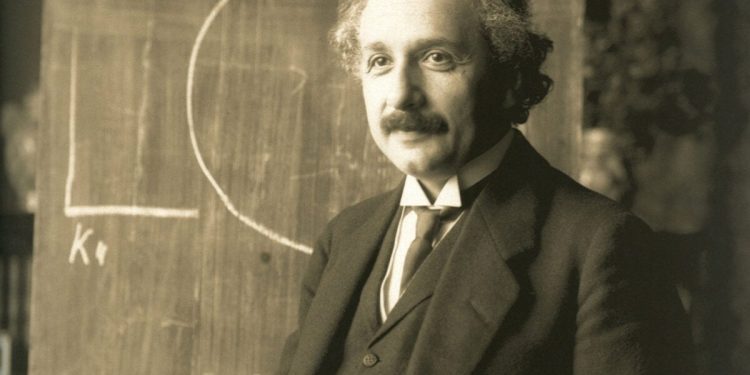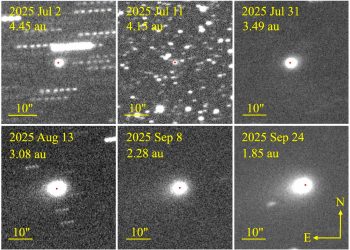Albert Einstein is undeniably one of the greatest names in physics. But Einstein, for all his contributions to space-time physics, was a human being confined to his historical era. While this makes his predictions all the more impressive, it also means that at other times Einstein was either slightly off the mark or – dare I say it – wrong.
That said, I would be remiss if I didn’t provide more context, lest I subscribe to some popular narratives about how Einstein hated this or that thing in physics. He didn’t really do it, and I don’t intend to discuss anything like that. In fact, a closer look at Einstein’s “mistakes” reveals the physicist’s insightful but cautious way of thinking about our universe.
1. Gravitational waves are too weak to be detected
When Einstein published his monumental papers on the general theory of relativity in 1916, he predicted that powerful ripples in space-time would manifest as wave forms of energy propagating throughout the universe. In 2015, the LIGO collaboration confirmed that gravitational waves were real; Einstein was right.
By 1936, many people had accepted Einstein’s predictions, except, apparently, the man himself. After reviewing his calculations, Einstein and his collaborator Nathan Rosen concluded that the calculations were incomplete. In a letter to fellow physicist Max Born, he wrote: “I arrived at the interesting result that gravitational waves do not exist, even if they had been taken as a certainty to a first approximation. »
After a famous fight with the journal Physical Review, as well as other physicists pointing out errors in his 1936 paper, Einstein revised his views again and took a more measured and hesitant approach. Gravitational waves may exist, but they should be too weak to detect. He was wrong.
2. Quantum entanglement cannot be real
Einstein’s alleged disdain for quantum mechanics overshadows his essential contributions to modern quantum mechanics. To be clear, Einstein accepted quantum mechanics phenomena but he was convinced that theory their description was incomplete.
One example is quantum entanglement, a strange state in which two separate particles are linked in such a way that measuring the state of one allows the state of the other to be predicted. Einstein’s reservations were that “elements of physical reality” had to be confirmed by “experiments and measurements” that could be translated into physical theory.
Unless these particles communicate faster than the speed of light, we are certainly missing a hidden, more realistic variable connecting the two. These arguments were introduced in a famous 1935 paper co-authored by Einstein, Rosen, and Boris Podolsky, and became known as the EPR paradox.
This paradox was later shown to be incompatible by both theoretical and experimental work, but parts of Einstein’s questions remain unanswered: Can we conceive of a flawless physical theory of entanglement?
3. Gravity and electromagnetism can be unified without quantum mechanics
Einstein spent the last 30 years of his life trying to formulate a single theory to unify all the forces of nature. Specifically, he sought to combine gravity and electromagnetism – and without relying on quantum mechanics, the arbitrariness of which he believed could be dispelled by his unified theory.
“I must be like an ostrich that always buries its head in the relativistic sand so as not to face evil quanta,” he joked in a 1954 letter.
“Physicists work with deeply held intuitions about how the world is constituted,” John D. Norton, a historian and philosopher of science at the University of Pittsburgh, told Gizmodo. Such intuitions “quietly but powerfully control the direction of their research,” he said. “For Einstein, the idea was that all the forces of nature could be combined into a single unified field.”
His attempts were never successful, although Einstein’s quest for a unified theory “made unification an important goal of physics…commonly called the ‘Holy Grail’ of modern physics,” according to the American Physical Society.
4. The universe is static and unchanging
For decades, the cosmological consensus has been that the universe has expanded – and continues to do so – at an exponential rate.
But this idea gained importance after Einstein’s time. Einstein believed in a static universe, introducing a “mathematical manipulation factor” into his equations, known as the cosmological constant. This constant suggested that there was a repulsive force counteracting the gravitational pull in the universe, balancing things so that the universe remained static.
What happened next was nothing short of ironic. Einstein later rejected the cosmological constant, considering it an arbitrary element that he had added to his equations. Then, in the 1990s, researchers revived this abandoned theory, giving it new life in the form of dark energy.
5. Black hole singularities cannot exist in nature
Was Einstein opposed to the notion of black holes? There is, surprisingly, a simple answer to that question, according to Norton: “Yes. He was against them.”
You may have already noticed a pattern: Einstein predicted a breakthrough in physics, then later disavowed his ideas. Similarly, general relativity hinted at the inevitability of black holes – until in 1939 Einstein flatly rejected their feasibility, at least within the framework of physics proper.
Einstein had a very mathematical view of space-time. A black hole so dense that all matter, including light, collapsed at what is now called the event horizon was “an unimaginable misfortune ().misfortune) for theory,” as Einstein noted at an academic meeting in 1922.
“Einstein preferred certain descriptions of his spacetimes based on coordinates,” Norton said. “These representations display such infinite divergences over the event horizon. They are mathematical expressions employing variables and their functions.”
Singularities, on the other hand, led to the collapse of these well-defined mathematical structures for Einstein. In a 1935 paper with Rosen, he noted that a singularity “brings so much arbitrariness into the theory that it actually nullifies its laws.”

Again, Einstein’s predictions took place well before the empirical observations that allowed physicists to create a geometric, workable description of black holes. Would Einstein have accepted the discoveries of LIGO or the Event Horizon Telescope?
“I’d like to imagine he’d be convinced,” Norton mused. “One thing I learned from studying Einstein’s work is that his next step is rarely what I thought would be the natural one. Predicting what Einstein would do is much more difficult. He was Einstein!”
6. “God doesn’t play dice.” »
On the subject of Einstein’s tendencies, he clearly did not like arbitrariness in physical models. This was the driving force behind his skepticism about quantum mechanics and singularities, and it was the reason he tried so fervently to devise a grand unified theory of physics.
A precursor to these ambitions might have been general relativity, a global theory unifying gravity and inertia. And he clearly succeeded, because general relativity “has survived every challenge for over a century and is the foundation of all modern work in gravitation and cosmology,” Norton said.
Again, Einstein did not reject indeterminism himself; rather, he believed that there was a deeper level of reality to which humanity had not yet arrived, a clearer theory that could sufficiently grasp the fundamental nature of the universe.
It’s easy for us now to nitpick Einstein’s older ideas, but in reality he “had his own methods and approaches and used them consistently and effectively,” Norton said. “Something worked.”
Indeed, if this list can serve as a guide, Einstein’s opposition to popular perspectives—including those he presented—gave rise to some of the richest and most thought-provoking debates in the field, many of which continue today.

As Norton says, it is difficult to predict how Einstein would react to how his ideas were proven or disproven with advances in physics. But I imagine he would have a lot of questions, with quite a few controversial takes!









